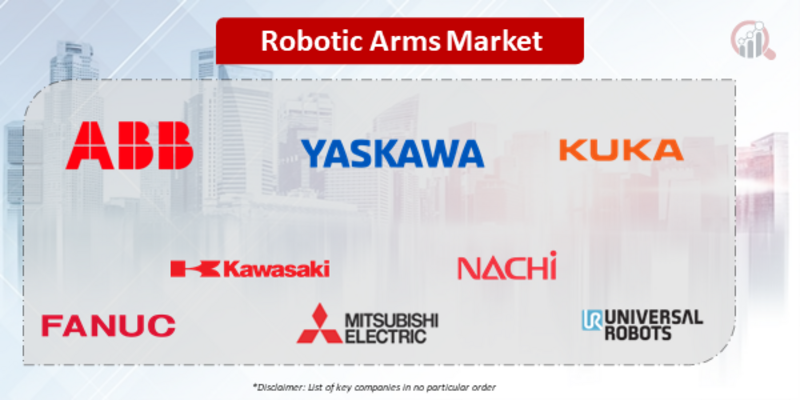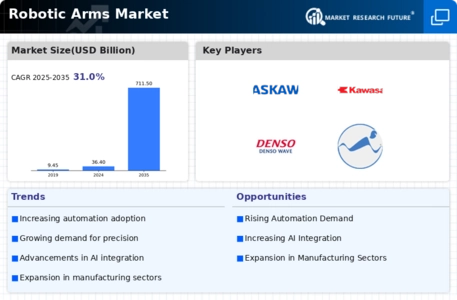Top Industry Leaders in the Robotic Arms Market

The Competitive Landscape of the Robotic Arms Market:
The robotic arms market is experiencing explosive growth, fueled by increasing automation demands across diverse industries. This dynamic landscape boasts a range of established players and emerging contenders, vying for market share through differentiated strategies and evolving technologies. To navigate this competitive terrain, understanding the key factors influencing market dynamics is crucial.
Some of the Robotic Arms companies listed below:
- ABB Group
- Yaskawa Electric Corporation
- KUKA AG
- Fanuc Corporation
- Kawasaki Heavy Industries, Inc.
- Mitsubishi Electric Corporation
- Denso Wave
- Nachi-Fujikoshi Corp.
- Universal Robots A/S
- Omron Corporation
- Stäubli Corporation
- Flexiv Ltd.
- ASIMOV Robotics Pvt. Ltd.
- Gridbots Technologies Private Limited
- Dobot.cc
- Seiko Epson Corporation
Strategies Adopted by Key Players:
To stand out in this competitive landscape, companies are employing various strategies, including:
- Vertical Integration: Expanding into component manufacturing and software development strengthens control over supply chains and fosters cost-efficiency.
- Strategic Partnerships: Collaborations with other technology providers, research institutions, and system integrators accelerate innovation and expand market reach.
- Mergers and Acquisitions: Consolidating market share through acquisitions or mergers allows companies to access new technologies, talent, and customer bases.
- Focus on Niche Markets: Targeting specific application segments with specialized robotic arm solutions creates a competitive edge in a particular market vertical.
- Investment in R&D: Prioritizing research and development efforts in areas like AI-powered robots, haptic feedback, and human-robot collaboration unlocks future market opportunities.
Market Share Analysis:
Assessing market share within the robotic arms market requires a multi-faceted approach, considering various factors beyond mere sales volume. These factors include:
- Product Portfolio: The breadth and depth of a company's product offerings, encompassing different types of robotic arms (articulated, SCARA, Cartesian, etc.) and payload capacities, cater to diverse customer needs and applications.
- Geographical Presence: Global reach and established distribution networks in key regions like Asia-Pacific, Europe, and North America provide a significant competitive advantage.
- Industry Focus: Specialization in specific application segments, such as automotive, electronics, healthcare, or logistics, allows for deeper market penetration and tailored solutions.
- Technological Advancements: Continuous innovation in areas like artificial intelligence, sensor integration, and collaborative robotics paves the way for market leadership.
- Brand Reputation: Established brand recognition and a track record of reliability and customer satisfaction build trust and attract new customers.
- Pricing Strategies: Competitive pricing structures and flexible financing options cater to varying budget constraints and market segments.
- Post-Sales Support: Robust after-sales support, including maintenance services, spare parts availability, and technical training, fosters customer loyalty and repeat business.
New & Emerging Companies:
Beyond the established players, a wave of new and emerging companies is disrupting the market with innovative approaches. These companies often focus on:
- Developing more affordable and accessible robotic arms: Targeting smaller businesses and startups by offering cost-effective solutions with simpler functionalities.
- Specializing in collaborative robots: Creating robots that can safely work alongside humans, addressing concerns about worker safety and human-robot interaction.
- Leveraging cloud-based robotics platforms: Offering software-as-a-service solutions for robot control, programming, and data analytics, simplifying deployment and maintenance.
- Emphasizing user-friendly interfaces and intuitive programming: Making robotic arms more accessible to non-technical users through simplified programming tools and graphical interfaces.
Latest Company Updates:
On Nov. 06, 2023- Meltio unveiled two innovations, Meltio Space and Meltio Robot Cell, to boost its metal 3D printing systems for the use of an industrial robotic arm. The metal 3D printing for robotic arms will offer ultimate solutions to create reliable large industrial parts. Meltio manufactures and develops wire-laser metal 3D printing technology for different industries.
On Oct. 10, 2023- Niryo, an industrial startup specializing in compact collaborative robotic arms, announced securing a €6.4 million financing round. This Series A funding will enable Niryo to transform the global collaborative robotics industry, expand its robotic arms into new use cases, develop professional-grade products, and solidify its international presence. This funding will also reinforce Niryo's development on promoting French innovation and Industry 4.0. Niryo's latest addition, the NED 2 educational robot, aims to shape the future of robotics through education and research.
On Mar. 03, 2023- Indian startup CynLr (Cybernetics Laboratories) announced that it is working towards building vision and intelligence into robotic arms used in the industry. The firm is building a camera platform that closely mimics the human eye and enables robotic arms to see and experience the world and interact with objects, irrespective of the light variation, type of object etc.
According to the firm, its camera-enabled robotic arms are already proven for operating in manufacturing setups where Computer Numeric Control(CNC) machines are being used. The company revealed that it has also entered into commercial engagements with a leading CNC machine manufacturer in India and two automotive OEMs in North America to offer different solutions.








